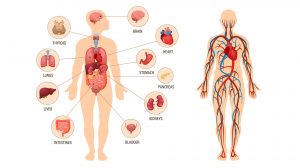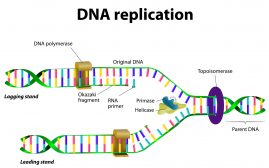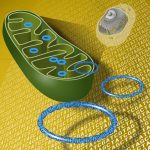
Eukaryotic cell
n., plural: eukaryotic cells
[juːˈkærɪˌɒtɪk sɛl]
Definition: cell of a eukaryote, i.e., an organism with well-defined nucleus (a cell organelle)
Table of Contents
Eukaryotic Cells Definition
What is a eukaryotic cell? Eukaryotic cells refer to the cells of (or derived from) eukaryotes, which are characterized by having a distinct, membrane-bound nucleus. The term “cell” is a common word in biology, anatomy, medicine, and cell science. It is the basic unit of life.
At the cellular level, cells may be classified as either prokaryotic or eukaryotic cells.
- Prokaryotic cells are cells of organisms without a “true nucleus”. Examples of two prokaryotic cells are domain Eubacteria (true bacteria) and domain Archaea. Their genetic material is located in a cytoplasmic region referred to as nucleoid.
- Eukaryotic cells are cells of organisms with a well-defined nucleus. They include protists, algae, fungi, plants, and animals.
Both prokaryotes and eukaryotes are made up of cells. However, some eukaryotic organisms are made up of only a single cell and are referred to as unicellular organisms. Other eukaryotes are made up of multiple eukaryotic cells organized into biological tissues, organs, and systems, and they are called multicellular organisms.
Humans, for instance, are made up of multifarious cells that function as a unit. For example, the muscle cells are cells that have acquired a special form and function, which enabled movements; they comprise the muscular tissues (skeletal muscles, smooth muscles, and cardiac muscles), which in turn, make up the muscular system.
Etymology: The word eukaryote came from the Greek “eu”, meaning “good”, “well”, “true” and “karuon”, meaning nut.
Variant: eucaryotic cells
Compare: prokaryotic cell
Watch this vid about eukaryotic cells:
Eukaryotic Cell Structures and Functions
The presence of a distinct nucleus and other eukaryotic organelles is what makes an organism or its cell eukaryotic. Cellular components (i.e., membrane-bound organelles and non-membrane-bound structures) that are typically present in eukaryotic cells are as follows:
- Nucleus
- Ribosomes
- Endoplasmic reticulum
- Golgi apparatus
- Lysosomes
- Vacuoles
- Endosomes
- Cytoskeleton
- Plastids
- Mitochondria
Let’s have an overview of the various cellular structures typically found inside a eukaryotic cell.
Nucleus
The presence of a nucleus is one of the distinctive characteristics of eukaryotic cells. The nucleus is a large organelle that is often the most prominent structure inside the eukaryotic cell.
Not all cells of a eukaryote contain a nucleus. For example, mammalian red blood cells lose their nucleus at maturity to increase their affinity for respiratory gases. Eukaryotic cells that lack a nucleus are described as “anucleate” as opposed to the nucleated cells that have a nucleus.
In eukaryotic cells, the nucleus acts as the command center. (Ref.1) It contains the chromosomes that bear most of the genes (nuclear DNA) of a eukaryote. The genetic code in the nuclear DNA is used by the cell for regulating the eukaryotic cell cycle, growth, differentiation, homeostasis, reproduction, heredity, and death.
The genetic material plus the other components of the nucleus are enclosed by this nuclear envelope (nuclear membrane). This envelope is a double lipid layer that separates the nuclear contents from the cytoplasm. The membrane-bound nucleus has an outer membrane and an inner membrane. Nevertheless, it is perforated with holes (called nuclear pores) so that certain molecules have a way to move to and fro. mRNA, for instance, leaves the nucleus after copying the genetic code from the nuclear DNA and brings it to the ribosome attached to the endoplasmic reticulum for protein translation (protein synthesis).
The eukaryotic cells divide by mitosis and meiosis. During cell division, the nuclear envelope and nucleolus disintegrate to allow spindle fiber and chromosome dynamics.
Ribosomes
The ribosomes are not exclusive to eukaryotic cells. Prokaryotic cells also have them. However, the ribosomes in eukaryotic cells, i.e. 80S, are larger than those in prokaryotes, i.e. 70S. (Ref.2) Nevertheless, both eukaryotic and prokaryotic cells tend to use ribosomes as a site of protein synthesis.
Endoplasmic reticulum
The endoplasmic reticulum is associated with biomolecular synthesis, carbohydrate metabolism, and drug detoxification. Two types exist — rough endoplasmic reticulum and smooth endoplasmic reticulum.
Golgi apparatus
The Golgi apparatus is involved in glycosylation, packaging of molecules for secretion, transporting of lipids within the cell, and giving rise to lysosomes. (Ref.3)
Lysosomes, vacuoles, and endosomes
The lysosomes digest, remove and recycle worn-out subcellular components. The cytoskeleton is responsible for maintaining cell shape. The vacuoles are for intracellular secretion, excretion, storage, and digestion. A plant cell, for instance, typically has a large central vacuole that is essential for osmoregulation. Endosomes, in turn, are involved in the endocytotic membrane transport pathway. The cytosol, which is the aqueous portion of the cytoplasm, consists of water, organic molecules (proteins, carbohydrates, lipids, etc.), and ions (primarily, potassium, sodium, chloride, bicarbonate, etc.).
Cytoskeleton
The cytoskeleton serves as the internal framework of the cell. Eukaryotic cells’ cytoskeleton is of three types: (1) microfilaments, (2) microtubules, and (3) intermediate filaments.
- Microfilaments are helical polymers of actin sub-units.
- Microtubules are tubular structures with a diameter of 25nm and lengths ranging from 200nm to 25μm. Examples are cilia and flagella
- Intermediate filaments are two anti-parallel helices or dimers of varying protein sub-units. Their diameters range from 8 to 12 nm. Examples are vimentin (mesenchyme), glial fibrillary acidic protein (glial cells), neurofilament proteins (neuronal processes), keratins (epithelial cells), and nuclear lamins
Semi-autonomous organelles: mitochondria and chloroplasts
The mitochondrion (plural: mitochondria) supplies the cell with biochemical energy (ATP) via cellular respiration. The plastids are involved in the manufacturing and storing of food. Chlorophyll-containing organelles called chloroplasts are an example of a plastid. The chlorophyll enables them to carry out photosynthesis.
Both mitochondria and chloroplasts are semi-autonomous organelles. They are double membrane-bound structures and contain DNA called mitochondrial DNA (mtDNA) and chloroplast DNA (cpDNA), respectively. They carry the code for certain proteins required for their metabolic activities. All eukaryotic cells possess mitochondria however not all of them have chloroplasts. Thus, the cell’s DNAs are of two kinds: (1) extranuclear, such as mtDNA and cpDNA and (2) nuclear, DNA present in the nucleus.
Only photosynthetic organisms, such as plants and algae, have chloroplasts. They obtain energy from the sun to manufacture their own food. See the eukaryotic cell diagram (B) for plant cell features. Many eukaryotic cells have a cell wall next to their plasma membrane. Thick cell walls are formed when the plant cell forms primary and secondary cell walls. Although many prokaryotic organisms do have cell walls, too, the plant cell walls are primarily cellulosic (with cellulose).
Plant and algal cells require it for cell rigidity and protection. Animal cells, in contrast, lack cell walls. Only the plasma membranes confer protection to the animal cells and their contents from the potential stressors outside. Nevertheless, animal cells are more flexible than plant cells simply because they lack the cell wall that makes the cell rigid.
See the eukaryotic cell diagram picture below.
(A) 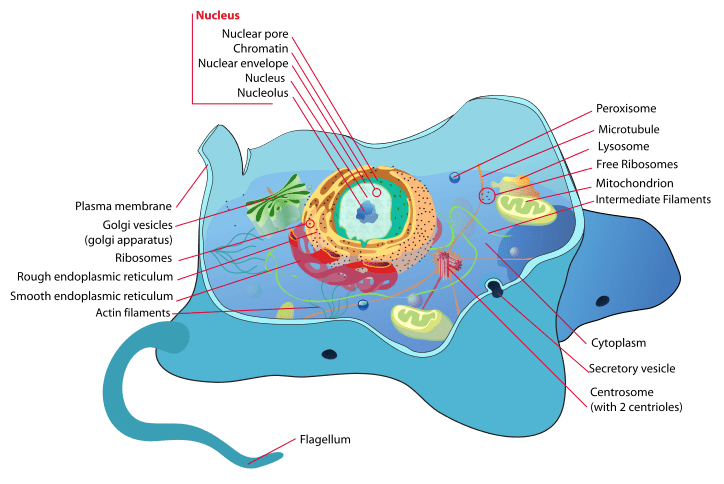 | (B)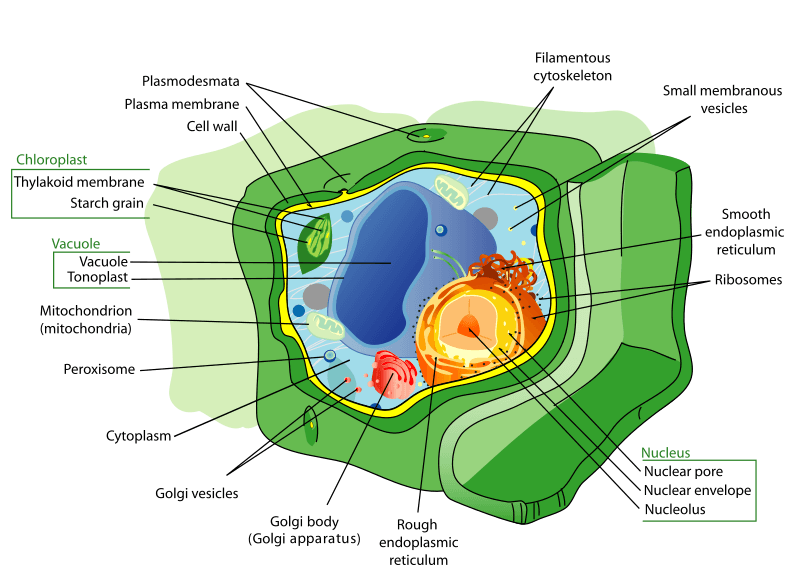 |
| Figure 1: Complex eukaryotic cell diagram of a typical animal cell (A) and a plant cell (B) with labeled parts. Cytoplasmic structures that are bound by biological membranes such as the nucleus, endoplasmic reticulum, Golgi apparatus, mitochondria, and plastids are found only in eukaryotic cells. | |
Cell Junctions
For multicellular organisms, adjacent cells are connected via cell junctions. Plants form plasmodesmata that provide channels between cells. In animal cells, similar connections are found in gap junctions. Other animal cell junctions are tight junctions, gap junctions, and anchoring junctions, which the cells use for cellular communication and transporting substances from one cell to another.
Types of Eukaryotic Cells
Eukaryotic cells may be classified into two groups based on the number of cells that make an individual organism: (1) unicellular eukaryotic cells and (2) multicellular eukaryotic cells. Unicellular eukaryotes include the protists. Multicellular eukaryotes include a variety of plant, fungal, and animal species.
Examples of Eukaryotic Cells
All animals, plants, fungi, and protists are eukaryotes. Thus, animal cells, plant cells, fungal cells, and protist cells are examples of eukaryotic cells. Their cells are organized into compartmentalized structures such as nuclei, mitochondria, chloroplasts, and Golgi bodies.
Where Did Eukaryotic Cells Come From?
According to the Endosymbiotic theory, the eukaryotes are conjectured to arise from the early eukaryotic cells that formed a symbiotic relationship with the early prokaryotic cells. They may have descended from a common microorganism ancestor that harbored a primitive prokaryotic cell inside. Over the years, the endosymbiosis of the two cells persisted for so long that eventually, the prokaryotic cell evolved into a subcellular component (organelle) of the eukaryotic cell. Some of the prokaryotes evolved into the modern-day mitochondria whereas those that are photosynthetic turned into chloroplasts. (Ref.4) Soon, these primitive eukaryotic cells diverged into different taxonomic kingdoms (e.g. Animalia, Plantae, Protista, and Fungi), each with distinctive characteristics that define one from the other.
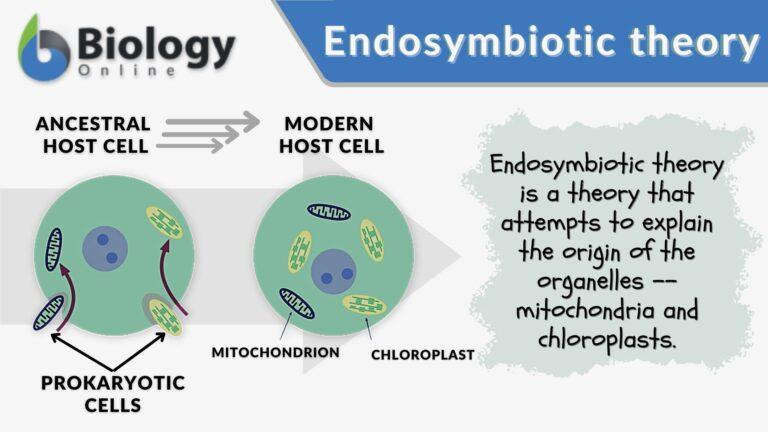
Take the Eukaryotic Cell Biology Quiz!
References
- Genetics Home Reference. (2020). What is a cell? Genetics Home Reference. https://ghr.nlm.nih.gov/primer/basics/cell
- Biology Online Editors. (2019, October 7). Ribosome Definition and Examples – Biology Online Dictionary. Biology Articles, Tutorials & Dictionary Online. https://www.biologyonline.com/dictionary/ribosome
- Biology Online Editors. (2019, October 7). Cell Definition and Examples – Biology Online Dictionary. Biology Articles, Tutorials & Dictionary Online. https://www.biologyonline.com/dictionary/cell
- Evidence for endosymbiosis. (2020). Berkeley.Edu. https://evolution.berkeley.edu/evolibrary/article/_0_0/endosymbiosis_04
©BiologyOnline. Content provided and moderated by BiologyOnline Editors.



